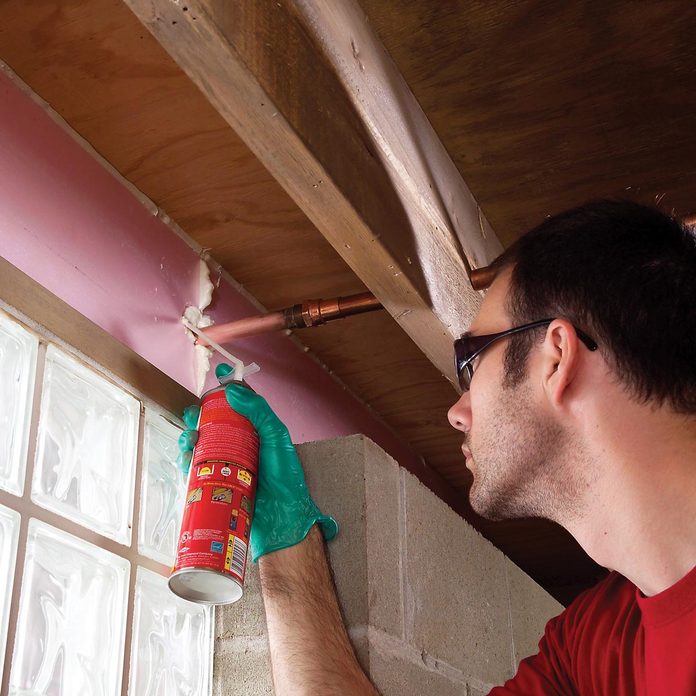We all know that water expands when it freezes. That’s not a problem with the ice cubes in your freezer, but if that ice forms in your plumbing, it’s a potential disaster. A frozen pipe can crack, spewing hundreds of gallons of water into your home. Fortunately, you can take steps to help prevent a catastrophe and put your mind at ease.
13 Tips for Winterizing Your House Plumbing

Shut Off Outdoor Faucets
Turn off outdoor faucets at their shutoff valves. Open the faucet and then open the bleeder cap on the shutoff valve to drain any water out of the pipe. If you don’t drain the pipe, it can still freeze and crack. Leave the bleeder cap open with a bucket underneath to catch any drips. If the dripping continues, your shutoff valve needs to be replaced.

Install Frost-Free Sill Cocks
Unlike a typical faucet, the working parts of a frost-free sill cock— valve, seat and washer—are located up to 18 in. inside the wall instead of right at the faucet. When the sill cock is properly installed, with a slight downward pitch, water drains from the pipe every time you turn off the knob at the faucet.

Disconnect Hoses
A water-filled hose left out in cold weather will freeze. If the hose is still connected to the faucet, ice can back up into the pipe inside your house, causing the pipe to crack. Disconnect all hoses from their faucets, drain them and store them for the winter.

Cover Hose Bibs
Insulated covers slow the heat loss from a pipe as it travels through the wall out into the cold. They provide some protection for very little cost.

Get an Early Warning
A Wi-Fi thermostat lets you control and monitor your home’s temperature using your smartphone. If the temperature in your house drops, you’ll get an email or text alert. Other types of alert systems are also available. Some send alerts to your cell phone via a phone jack in your house. Others send an alert to a landline or cell phone.

Install Heat Cable
Heat cables are a perfect solution for vulnerable pipes. They have an integral thermostat that senses pipe temperature, turning the heat on and off as needed to keep the pipe from freezing. You’ll need an accessible outlet to plug in the cable.

Seal Rim Joists
The rim joist is a likely area for cold air intrusion. Seal cracks or holes using expandable foam and then insulate between the floor joists. Be sure that you don’t insulate a pipe from the heat in the rest of the house. Also, inspect around holes where cables, wires or pipes pass through an exterior wall. Insulate where you can, and seal drafts with caulk or expandable foam. After insulating, be sure you have combustion air for the furnace coming in through a makeup air pipe.

Shutoff Water Lines Before Leaving for Vacation
If you’re leaving town for a few days or more, turn the water off at the main shutoff. That way, if frozen pipes do crack, you’ll have far less damage. Shut off your automatic icemaker so it doesn’t continually try to make ice, burning out the motor. Even if the ice bin is full, the ice will evaporate and the icemaker will try to make more.

Insulate Pipes
If you have pipes in an unheated area, such as a crawl space, an attic or a garage, use heat cable and cover it with pipe insulation. Pipe insulation alone does little, as it’s only a matter of time before cold air can reach the frozen pipes. In fact, insulating pipes without also using heat cable can prevent warm air from getting to them.

Insulate Garage Doors
If you have water lines in the garage, insulate the garage door, if not the whole garage. Consider a combination of heat cable and insulation as well. If it’s really cold, put a portable heater in the garage.

Keep Temperatures Steady During Cold Spells
What constitutes a cold snap depends on your climate and your home’s insulation. A temperature of 32 degrees F isn’t cause for alarm in Minnesota, but it might be in Mississippi. So during extreme cold, bypass your thermostat’s program and leave the temperature steady. You may even want to turn it up a couple of degrees.

During a Cold Snap Open Kitchen Cabinet Doors
Being behind closed doors, kitchen plumbing frozen pipes are vulnerable, as the heat from the rest of the house can’t reach them. Open the cabinet doors to allow heat to circulate into the cabinets. A fan or portable heater pointed inside the cabinet also helps circulate warm air.

During a Cold Snap Leave Faucets Running
A trickling faucet acts as a relief valve for the pressure that builds up if frozen pipes do occur. That pressure relief can prevent frozen pipes from cracking. A slow trickle is all you need. It’ll bump up your next water bill a bit, but compared with major home repairs, that’s an easy price to pay. Don’t leave a faucet running if the drain is on an exterior wall, though; the drain can freeze, causing the sink to overflow.



















